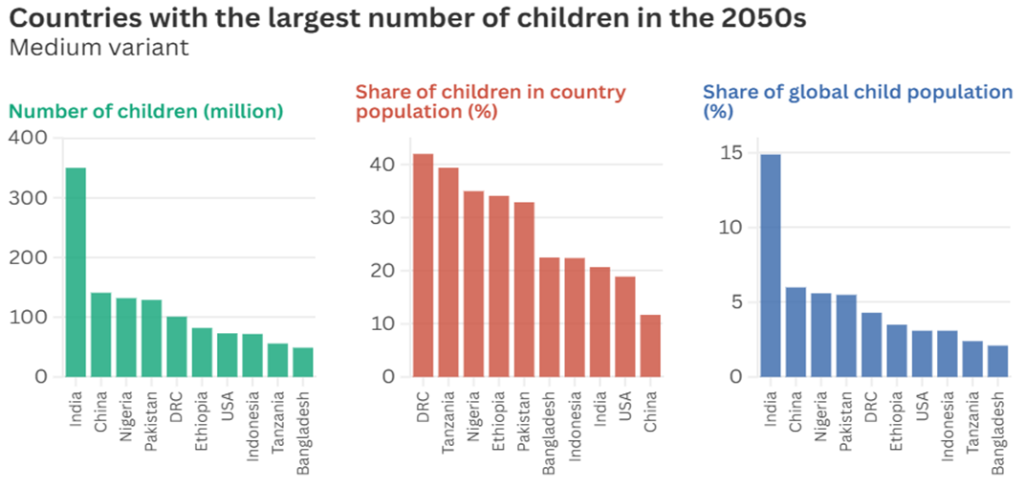Context:
According to the recently released UNICEF’s State of the World’s Children 2024 (SOWC-2024) report, nearly half of the world’s children – about 1 billion – live in countries that face a high risk of climate and environmental hazards.
Key Highlights of SOWC-2024:

The report was launched on World Children’s Day (20 November) under the theme “Listen to the Future focusing on the voices of children and young people about the world they want.
The report identifies three key trends shaping children’s lives by 2050:
- Demographic shifts,
- Climate and environmental crises, and
- Emerging/Frontier technologies.
The report notes that by the 2050s, the global child population is projected to stabilize at around 2.3 billion.

South Asia will remain a major region with a large child population, but Eastern, Southern Africa, and West & Central Africa will also experience significant growth in their child populations.
The probability of a child surviving to the age of 5 (given surviving as a newborn), rises by 1 percentage point from the 2000s to 99.5 percent.
Life expectancy will increase, with girls reaching 81 years and boys reaching 76 years, up from 70 and 66 respectively for children born in the 2000s.
Vulnerabilities mentioned in the report:
- Children’s developing bodies are especially vulnerable to pollution and extreme weather.
- From birth, children’s brains, lungs, and immune systems are at risk from air pollution, extreme heat, and extreme weather events.
- Air pollution can have lifelong impacts on children’s respiratory health and development.
Impact of Climate Change:

- Rising temperatures cause an increase in mosquito populations, spreading diseases like malaria, dengue, and Zika among children.
- Floods contaminate water supplies, leading to waterborne diseases, a major cause of death for children under five.
- Climate-related disasters can cause trauma, anxiety, and helplessness among children.
- By the 2050s, more children will be exposed to extreme climate events compared to the 2000s.
- 400 million students worldwide have already experienced school closures due to extreme weather since 2022, which not only violates children’s rights but also stifles economic growth.
Impact of technology and digital divide:
- Over 95% of people in high-income countries are connected to the Internet, while only 26% in low-income countries have access.
- The digital divide exacerbates inequalities, especially in regions with rapidly growing child populations.
- While digital technologies could empower children, they also expose them to online risks, such as sexual exploitation and abuse.
- Technologies like artificial intelligence (AI), neurotechnology, renewable energy, and vaccine breakthroughs have the potential to improve childhood in the future.
Key Recommendations from the report:
UNICEF recommends that governments and the public sector, businesses, non-governmental and human rights organizations, and civil society to act urgently in three key areas:
- invest in education, healthcare, and child-responsive infrastructure;
- integrate climate resilience and sustainability, invest in renewable energy and promote solutions to cut emissions by 43 per cent by 2030;
- and promote digital equality while ensuring safe, rights-based technology development. These actions are crucial to secure a better future for children amidst demographic, environmental, and technological challenges.

